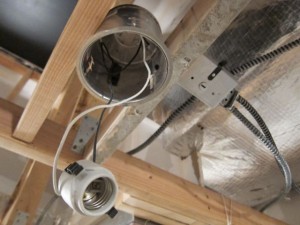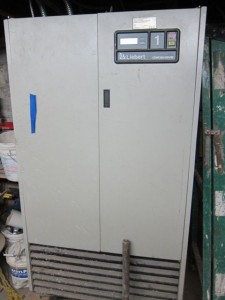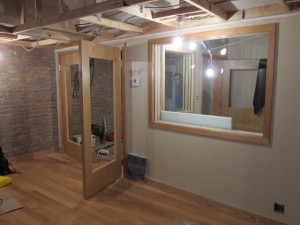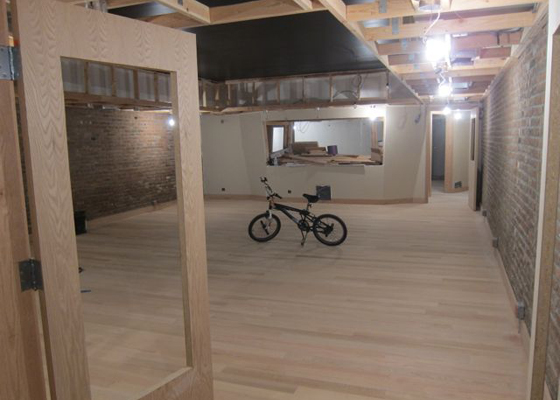Marc Alan Goodman’s Building Strange Weather Blog: Everything Else
Latest in the “Building Strange Weather Blog” series by producer/engineer and studio owner Marc Alan Goodman. Click to start at Step 1: Finding A New Home; #2: Design; #3: Waiting For Permits (Part 1) and #4: (Part 2); and #5: Stops & Starts, #6: Demolition, #7: The Structural Work, #8 The Joys of Home Ownership, #9 Rain, Rain, Rain, #10 A Control Room Is Born, #11 Plumbing Inspections aka More Delays, #12 The Timing Game, #13 Framing & Wiring, and #14 Sheetrock, Soffits & A Race To The Finish.
It’s been a few months since our last entry, mostly because things have been moving too quickly to sit down and document them! Some of the things we’ve accomplished while waiting for Tony and his crew to come back and do the acoustical finish work are: Finishing the drywall, installing the doors and trim, painting, putting in the iso booth windows, installing the boilers for the radiant heat flooring, putting in the light fixtures and taking care of all of the studio electricity. I’ll start at the end.
A few years ago, towards the beginning of the process, I purchased a Liebert Datawave Magnetic Synthesizer from a surplus depot in Kentucky. The Datawave is essentially a series of gigantic transformers and capacitors designed to convert standard wall electricity into a perfect 120V sine wave with less than 0.01% Total Harmonic Distortion. Low THD levels are something that you’ll hear thrown around in audio design, but rarely on the power side of the system.
It was originally installed in a data center, where the computers were very sensitive to changes in the voltage and quality of the electricity coming into the building. Since the early 2000’s, magnetic synthesizers have slowly gone out of production and been replaced by UPS, or Uninterpretable Power Supplies, which are essentially gigantic batteries. The battery is slowly charged, and power is released as a clean, even stream.
The advantage of a UPS over a Magnetic Synthesizer is that it will continue working during a blackout. Since this is extremely important for computer databases, it makes sense for them to upgrade, and the falling costs of battery technologies have driven the Magnetic Synthesizer out of existence.
However for our purposes a UPS would be overkill. We’re simply trying to get clean, even power, not to avoid potential outages. The unspoken downside of the newer technology is that current battery designs only last ten to fifteen years at most. On the other hand, the Datawave is almost entirely made of transformers and capacitors. The transformers will last for hundreds of years if properly taken care of, and the capacitors are relatively easy to replace when they fail.
The most difficult part of the installation was getting the unit into our basement. It weighs nearly 1,500 lbs, and when we took the outer casing off, it cleared our basement stairs by less than half an inch. Now that it’s down there it’s going nowhere for a long, long time. It and our plate reverb will become old friends!
We plugged the unit in and it was working perfectly, I even brought out the oscilloscope to measure it. However the hum from the transformer was audible throughout the whole building! So we were forced to decommission it for the time being until we have an opportunity to build a ventilated room to isolate it. Overall, it was a lot of work for very little reward, but hindsight allows me to see that not every plan is going to work out fully. If the city power ever gives us a problem we have a solution available on hand.
Also in the basement, we constructed a new boiler room. Previously the boilers had been out in the middle of the space, which is far from legal in Brooklyn. We built a cinderblock room for them to live in, and put three new boilers (one for each floor) as well as two water heaters in it. The manifold system for the radiant heat on both the first and second floors is also laid out in the boiler room.

We used renovation style cans for lighting in the soffits because they’re smaller. Hence more room for absorbtion.
While doing this, I had the electricians wire the rest of the basement for power, both clean and dirty, so I can set up a repair bench for the constant stream of malfunctioning vintage equipment that our studio supplies. As far as I can tell, something breaks every single day that we’re open. I’ve trained myself as a passable tech at this point, and it seems like I’m capable of fixing 95% or so of the problems that come up. It will be nice to finally have a workspace that isn’t slowly eating my entire kitchen.
The light fixtures went in fairly easily. We used renovation style cans rather than normal ones as they’re smaller and better sealed in the back. None are actually inset in the ceiling; instead they’re set in the bottoms of the soffit, which holds the HVAC ducting, and in the acoustical clouds that are going in the live room, control room, iso booth B and the lounge.
I had to come up with some sort of lighting solution for the sound lock, machine room and iso booth A, all of which have rather low ceilings. I ended up purchasing some super low-profile track lighting and placing it around the perimeter of the rooms. It actually looks pretty good, though I’m pretty sure some of our taller clients could clip their heads on them if they get too close to the walls.
The hardest part of this whole period of time may have been the doors and windows. The interior windows (between the iso booths and the live room…we’re leaving the control room window until after the console is delivered) are made of two panes of different thicknesses of glass, set on neoprene and isolated from each other with a neoprene strip.
Since the intent is to make them air-tight they needed to be EXTREMELY clean. Daniel and I spent about two and a half hours wiping the 2×3-foot iso booth windows down before we were confident enough to install them. There are still a few small specks but they’re hardly noticeable unless you put a light directly on them.
However when we came in the next day to install the larger window between iso booth B and the live room we discovered that the general contracting crew had put them in without us! Some serious scrutiny has led us to leave them as they are, but we probably would have done a more thorough job if we’d been able to do it ourselves.
The doors are all standard solid core particle board. They’re extremely heavy and difficult to hang, but once we got them in place they do a pretty good job of blocking sound even without the door seals installed. For the doors’ windows we cut rectangles out of the door body and had the glass shop build us glass sandwiches with non-metallic spacers. That way, they’re responsible for getting the two panes clean, and they were relatively easy to just drop in the doors and caulk around. A few of them rattled after a day or two and needed to be resealed, but it was a comparatively simple job and turned out beautifully.
Next we wait for Tony and his crew to get back in town and tell us everything we’ve done wrong. It should be an enlightening experience, and at the end of it, two and a half years after this project started, we’ll have a functioning recording studio. I hope.
Click to see more photos of the process over on our photoblog!
– Marc Alan Goodman
strangeweathersound [at] gmail dot com
http://strangeweatherbrooklyn.com
Marc Alan Goodman is a producer/engineer who’s worked with artists such as Jolie Holland, Marc Ribot, Shudder to Think, Dub Trio, Normal Love, Alfonso Velez, Angel Deradoorian and Pink Skull.
Please note: When you buy products through links on this page, we may earn an affiliate commission.









